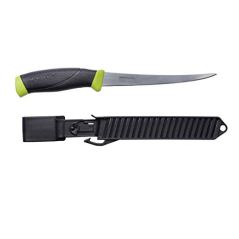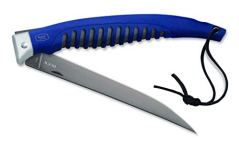
This sturdy knife comes in 2 sizes and is built to withstand whatever dirty job you can throw at it.
This sturdy knife comes in 2 sizes and is built to withstand whatever dirty job you can throw at it.
Stainless steel blade with an ergonomic, easy-grip handle. Available in 3.5-inch and 6.1-inch sizes. Plastic sheath covers the blade when not in use. Does not absorb odors.
The sheath is flimsy and prone to breaking, so you may want to replace it with a better option.

A well-made choice and sheath suitable for use in the kitchen or the great outdoors.
A well-made choice and sheath suitable for use in the kitchen or the great outdoors.
Stainless steel blade with a comfortable rubber grip. Soft blade that's designed to bend instead of break. Available in 7-inch and 9-inch sizes. Knife clicks into the included plastic sheath and stays in place.
The knife holds an edge well, but it doesn't come sharpened.

This high-quality blade is designed for professional chefs, but it's a good option for the beginning chef, too.
This high-quality blade is designed for professional chefs, but it's a good option for the beginning chef, too.
Soft, nonslip handle comes in 8 colors. Protective finger guard. One-piece stainless-steel blade. Blade comes very sharp. Comfortable to hold and easy to maneuver. Reasonably priced.
Users have said that this knife dulls fairly quickly and requires regular resharpening.

This is the perfect on-the-go model because it's compact and folds up easily for storage in a pocket or tackle box.
This is the perfect on-the-go model because it's compact and folds up easily for storage in a pocket or tackle box.
A 6.5-inch blade. Folds up for compact storage inside a pocket or bag. Anti-slip grip. Stainless steel blade. Holds an edge well and is ready to use right out of the box.
There have been a few complaints of the folding mechanism breaking.

This electric knife does most of the work for you when it’s time to fillet a fish.
This electric knife does most of the work for you when it’s time to fillet a fish.
The blade is 7.5 inches long with an 8-foot power cord so you can adjust your angle of attack based on the size of the fish. The motor is quiet and has 110 volts of power.
It can generate too much heat if used too long.

We recommend these products based on an intensive research process that's designed to cut through the noise and find the top products in this space. Guided by experts, we spend hours looking into the factors that matter, to bring you these selections.

Cooking show hosts may laud the chef’s knife as the heavyweight cutting implement in the kitchen, but the fillet knife quietly holds its place as the go-to blade for making precise cuts of meat or fish. On a whole fish, it can separate the fillet from the ribs, the backbone, and even the skin without damaging the delicate flesh.
Once cooks understand the versatility and fine control that a fillet knife provides, they’ll spend as much time as they need to find the perfect one. Even for the casual cook, a good fillet knife can be a game-changer in the kitchen. Fillet knives are also a standby for avid fishermen and hunters, who take them on every excursion.
However, a good fillet knife is not necessarily the biggest or thickest blade. Consider what kind of protein you’ll be slicing with it — delicate fish, chicken, pork, or red meat — and how often you'll use it.

Fillet knives come in several lengths, from as short as four inches to nine inches or longer. The shortest knives are good for slicing small fillets from panfish and for decorative cuts, while longer knives work for larger fish, but these aren’t hard-and-fast rules. A wide variance in blade flexibility, the overall knife balance, and other factors can change the behavior of a fillet knife, and it’s not unusual to see a cook trimming and filleting a piece of poultry or fish with a shorter or longer blade than one might think.
Where the fillet knife will be used also matters. Home-based cooks may not need to worry about how well a knife is constructed, but fishermen and hunters need a blade that won’t rust in damp environments and that will hold its edge for several uses, and they need a handle that won’t warp or mildew.




















To choose the best fillet knife for your needs, consider these main features:
Handle: Designed to be sturdy without hindering control of the knife, the handle should fit the user’s hand and feel comfortable when held lightly or with a firm grip. Handles are made of an array of materials, including wood, bone, metal, or plastic.
Guard: Located between the handle and the blade, the guard, often just a metal “lip” extending from the handle, keeps fingers from sliding forward onto the blade.
Blade: Fillet knife blades can be found in varying lengths ranging from four to nine inches (even longer for professional and industrial uses). The blade usually curves upward slightly toward the tip.
Taper: The point of a fillet knife tapers sharply down to the tip. Contemporary fillet knives tend to curve sharply upward as they taper, a shape that lends itself well to detail work.
Tip: The tip of the knife is always sharply pointed and can be used to remove tiny bones from fillets.
Thickness: Fillet knives have thinner blades than other knives of the same length.
Flexibility: This is a key feature of a fillet knife. A flexible blade can bend slightly around the tougher parts of a fish so that as much of the meat as possible is separated from the bones in the first cut. Fillet knives have varying degrees of flexibility, and each user has a preference.
Fillet knives can be found for as little as $5 to $9, though the knives at this price point tend to lose their edge easily and little attention is paid to ergonomics.
Hunt for knives from $19 to $39 for a range of grips, weather resistance (for fishing and hunting), and flexibility with good feedback.
The best blades are in the $70 to $119 price range, with the best of this group balancing practicality and attractive design.
The smaller the blade length of a fillet knife, the smaller the fish should be.
Longer fillet knives can make it easier to remove the skin from a fillet.
Care for your knives and keep the knife blade sharp at all times to maintain control of the cuts.
When filleting, slide the knife gently between the meat and the bones so that the meat separates. Otherwise, the knife may slice through the bone.
To remove the skin from fish or poultry, turn the newly cut fillet so the skin side is on the cutting board and ease the fillet knife between the meat and skin, pushing away from you.
Grip a fillet knife firmly, but not too tightly, and keep your wrist loose during use.
Always cut away from your body when using any knife.
Clean and dry a fillet knife completely before storing it in its sheath, knife block, or edge protector.

Q. How do I figure out how flexible a fillet knife blade is?
A. Test the flexibility of a fillet knife by placing the blade on its side on a cutting board, facing away from the user. Lift the handle so that only the tip rests on the board. Press down gently to flex the blade downward.
Q. What advantages does a fillet knife have over a boning knife or a hybrid knife?
A. The difference is in the purpose of each blade. The flexible fillet knife is thin enough to slide easily between the skin and the meat of a fish or poultry. Boning knives have stiffer, thicker blades that can tear through the skin, making it much harder to separate from the meat. However, cooks who fillet meat, poultry, and fish, and who don’t want to keep switching from one blade to another, may prefer a hybrid boning-fillet knife.
Q. What is the point of the upward taper that fillet knife blades have?
A. The curved end of the fillet knife blade and its severe taper makes it possible to perform intricate cuts. The curve can even be used as a unit of measure, as it begins at the last third of the blade. For example, when filleting a panfish, making an initial cut along the backbone is recommended, and the tapered end is the best part of the knife to make this shallow cut. The upward taper is helpful in the decorative cutting of vegetables and fruit, letting the user make precise, curved slices.
Get emails you’ll love.
Learn about the products you’re wondering if you should buy and get advice on using your latest purchases.
